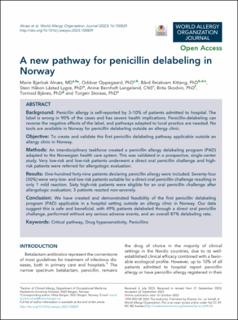| dc.contributor.author | Alnæs, Marie Bjørbak | |
| dc.contributor.author | Oppegaard, Oddvar | |
| dc.contributor.author | Kittang, Bård Reiakvam | |
| dc.contributor.author | Lygre, Stein Håkon Låstad | |
| dc.contributor.author | Langeland, Anine Bernhoft | |
| dc.contributor.author | Skodvin, Brita | |
| dc.contributor.author | Bjånes, Tormod Karlsen | |
| dc.contributor.author | Storaas, Torgeir | |
| dc.date.accessioned | 2024-04-17T13:14:32Z | |
| dc.date.available | 2024-04-17T13:14:32Z | |
| dc.date.created | 2023-11-09T10:36:01Z | |
| dc.date.issued | 2023 | |
| dc.identifier.issn | 1939-4551 | |
| dc.identifier.uri | https://hdl.handle.net/11250/3127074 | |
| dc.description.abstract | Background: Penicillin allergy is self-reported by 3–10% of patients admitted to hospital. The label is wrong in 90% of the cases and has severe health implications. Penicillin-delabeling can reverse the negative effects of the label, and pathways adapted to local practice are needed. No tools are available in Norway for penicillin delabeling outside an allergy clinic.
Objective: To create and validate the first penicillin delabeling pathway applicable outside an allergy clinic in Norway.
Methods: An interdisciplinary taskforce created a penicillin allergy delabeling program (PAD) adapted to the Norwegian health care system. This was validated in a prospective, single-center study. Very low-risk and low-risk patients underwent a direct oral penicillin challenge and high-risk patients were referred for allergologic evaluation.
Results: One-hundred forty-nine patients declaring penicillin allergy were included. Seventy-four (50%) were very-low- and low risk patients suitable for a direct oral penicillin challenge resulting in only 1 mild reaction. Sixty high-risk patients were eligible for an oral penicillin challenge after allergologic evaluation; 3 patients reacted non-severely.
Conclusion: We have created and demonstrated feasibility of the first penicillin delabeling program (PAD) applicable in a hospital setting outside an allergy clinic in Norway. Our data suggest this is safe and beneficial, with 49% patients delabeled through a direct oral penicillin challenge, performed without any serious adverse events, and an overall 87% delabeling rate. | en_US |
| dc.language.iso | eng | en_US |
| dc.publisher | Elsevier | en_US |
| dc.rights | Attribution-NonCommercial-NoDerivatives 4.0 Internasjonal | * |
| dc.rights.uri | http://creativecommons.org/licenses/by-nc-nd/4.0/deed.no | * |
| dc.title | A new pathway for penicillin delabeling in Norway | en_US |
| dc.type | Journal article | en_US |
| dc.type | Peer reviewed | en_US |
| dc.description.version | publishedVersion | en_US |
| dc.rights.holder | Copyright 2023 the authors | en_US |
| dc.source.articlenumber | 100829 | en_US |
| cristin.ispublished | true | |
| cristin.fulltext | original | |
| cristin.qualitycode | 1 | |
| dc.identifier.doi | 10.1016/j.waojou.2023.100829 | |
| dc.identifier.cristin | 2194427 | |
| dc.source.journal | World Allergy Organization Journal | en_US |
| dc.identifier.citation | World Allergy Organization Journal. 2023, 16 (11), 100829. | en_US |
| dc.source.volume | 16 | en_US |
| dc.source.issue | 11 | en_US |

